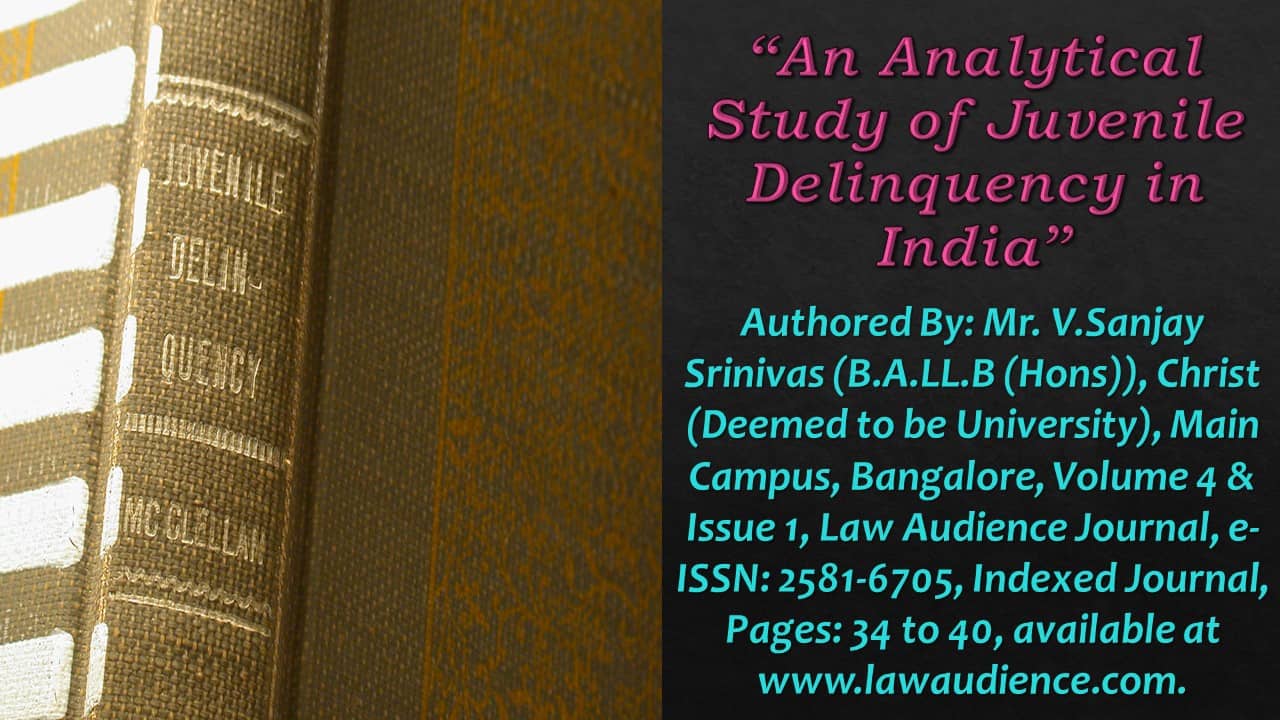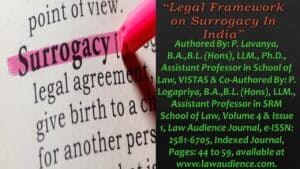Click here to download the full paper (PDF)
Authored By: Mr. V.Sanjay Srinivas (B.A.LL.B (Hons)), Christ (Deemed to be University), Main Campus, Bangalore,
Click here for Copyright Policy.
ABSTRACT:
“Future of India depends on the children. So, they should be getting every possible attention and care for the betterment of the country. The situation is what decides the future of a kid, if a child is born and raised with proper care and attention then that child will grow into a respected person in the society. Many factors including poverty, economic factors, family situations, etc., play a crucial role in juvenile delinquency. This paper deals with the problem of juvenile delinquency in India and talks about the various causes of juvenile delinquency and prevention of juvenile delinquency.
This paper is focused on five main issues, first issue is who is a juvenile? And what is juvenile delinquency? The second issue is, Is it necessary to reduce the age of juveniles to 18? The third issue is, what are the causes of juvenile delinquency. The fourth issue is, what is the prevention of juvenile delinquency? The fifth issue is, what are the loopholes present in Juvenile Justice (Care and Protection of Children) Act? These issues will cover the reasons for rapid increase in juvenile delinquency and provide the necessary prevention methods for the future”.
Keywords: Juvenile, Delinquency, Poverty, Society, Child.
I. INTRODUCTION:
Juvenile Delinquency is not a sudden aroused problem in India, it is happening for a very long time back also. The commission of crimes by minors or children, below the age of 18, is defined as Delinquency. The law gives more attention towards the physiological aspect of the children than seeing it as a legal problem. Whatever act done by any person below the age 18 would not be considered as a crime, it is considered as delinquency. There are two types of offences under Juvenile Delinquency, Status and delinquent offences. Status offences are the offences which are only applicable to children below the age of 18, not to adults[1]. It is not considered as an offence when it is done by adults, it is considered as an offence only when it is committed by children below the age of 18. Examples of status offences are drinking, smoking, not attending the school properly, violation of curfew, etc. According to the stats, 20% of the crimes committed by the juveniles are considered as status offences. Delinquent offences are the offences that are considered as a crime when it is committed by all age groups. Some examples of delinquent offences are theft, shoplifting, battery, assault, fraud, etc. Helping the juvenile delinquents and changing their minds about the past is one of the crucial roles of the Judiciary.
For the adjudication of the juveniles, a special court and special magistrates have been appointed. It also makes provisions to set up informatory homes for the juvenile delinquents. The main reasons for juvenile delinquency are poverty, broken homes, family tensions, emotional abuse, rural-urban migration, breakdown of social values and joint family system, atrocities and abuses by parents or guardians, faulty educational system, the influence of media besides the unhealthy living conditions of slums and such other conditions.[2]
II. MEANING OF JUVENILE DELINQUENCY:
The behaviour of a minor child is marked by criminal activities, persistent antisocial behaviour, or disobedience which the child’s parents are unable to control. It is originated from two Latin words iuevnilis which means ‘of or by belonging to youth’, iuvenis which means ‘young person’. Delinquency was derived from a Latin word ‘delinquentia’ meaning ‘a fault or crime’.[3] The commission of crime by any person under the age of 18 is considered as Juvenile delinquency. Juvenile delinquency is a social evil and socially unacceptable Behaviour of minors and adolescents. Youth It is housed in juvenile prisons and orthodontic facilities. Then different Corrective actions have been taken to change their behaviour, Develop a positive direction. Crime is increasing with population growth and cultural complexity.
III. CAUSES OF JUVENILE DELINQUENCY:
III.I INDIVIDUAL FACTORS:
Individuals have several factors that can lead to criminal activity. Children with no education and poor maturity are likely to involve in delinquent acts. Some other factors which involve children to do illegal acts are regression, instability. Mental health factors are also part of the individual factors. The mental state of the individual is very important to his behaviour in society.
III.II FAMILY FACTORS:
Family factors can include ongoing family feuds, neglect and abuse, or lack of proper parental supervision. Children whose parents do not respect national laws and social norms can drink the same. In addition, the child with the weakest attachment to the family seems to be the same adolescent who is engaged in inappropriate activities.
III.III SUBSTANCE FACTORS:
Substance abuse is found in most cases involving juvenile delinquents. Adolescents today use more powerful medicines than adolescents 10 years ago. In addition, these children begin to take medicine at a young age. The use of these illegal or legal substances causes crime in these young people. In addition, if the child is under the influence of drugs or alcohol, then such child probably ends up in doing delinquent act.
III.IV SUDDEN URBANIZATION:
Due to the current needs of the country and after the implementation of many industries a rapid urbanization is occurring. As a result of which more families move from village to city area, which causes more crowd, over population in urban areas. To meet the ends of the family both men and women have to go to work, so their children become negligent and unnoticed. Outsiders may drag such unnoticed children into some illegal activities or they maybe influenced by poverty.
III.V ECONOMIC PROBLEMS:
Most of the underage children involving in illegal activities are result of Economic factors influencing their families. Due to the family situation as their parents failed to provide them basic necessities such as food, water, clothes, shelter, etc., youth themselves aims their attention towards them. [4]
III.VI EFFECT OF SOCIAL MEDIA:
Social media nowadays is having a poor than a good imprint on younger minds. There is a developing problem that the social media which surely inform, teach and entertain have turned out to be a supply of infection in child`s minds. They generally tend to provide sensational statistics approximately the crime, i.e., the sorts and strategies of the weapons. And this in addition results in children both committing the antisocial act with vengeful attitude or they generally tend to teach their partners approximately the same. Motion films display that the crimes are interesting and generally tend to expose that there are methods wherein the regulation may be eradicated. The prime culprits are the ones movies and applications loaded with violence and vulgarity. This kind of violence and vulgarity alleges to induce visitors for committing rapes, robbery, attack or murder. In India, a growing united states wherein the literacy degree is low these styles of movements have extra effect on the overall mindset and behaviour.[5]
III.VII MENTAL INSTABILITY:
It has been proved from a study that the children who is being involved in illegal activities are mostly mentally unstable. They might do such acts as a result of mental deficiency. Children who are under such condition has been used by criminals to involve in illegal activities.
IV. OVERVIEW AND LOOPHOLES OF JUVENILE JUSTICE (CARE AND PROTECTION OF CHILDREN) ACT, 2000:
After Nirbhaya case, major change happened in the Juvenile Justice act. A girl was gang-raped in a moving bus in Delhi. One of the boys is minor in that gang, so it got back the discussion about fixing the age limit of juvenile. Under the current legal system, the maximum punishment a juvenile can get is 3 years in reformatory home. A committee was formed under Justice J.S Verma, The Committee on amendments to criminal law, rejected the discussion about reducing the age of juveniles to 16. It is unnecessary to reduce the age of juveniles as the repetition of murder has been declined in the past few years. It also proposed that certain reforms and amendments are necessary in the Juvenile Justice (Care and Protection of Children) Act, 2000.
There are certain loopholes present in the Juvenile Justice (Care and Prevention of Children) Act, 2000. Too much power is with the Juvenile board is one of the major issues. There are no clear laws that what are the cases that are transferred to the court, the board uses this confusion to exert its power. The board sometimes orders a particular case to be dealt in adult court and sometimes it does not refer to adult court. In Mukesh and Ors vs. State of Delhi case, a guy who is below 18 years have been sentenced to 3-year custody. He is an active member of the gang, so he cannot be excluded as he is a minor. It created a chaos that the Juvenile Justice Act should be amended. [6]
V. PREVENTION:
It is extensively believed that early-segment intervention is the best technique to save you juvenile delinquency. Control of delinquency wishes powerful implementation of Juvenile Justice Act, 2015 with complete public recognition and right orientation and education to specialists and regulation enforcement businesses. Thus, they regain their self-confidence, that is typically misplaced due to the callous mindset of the society. The technique of the businesses like police worried in the gadget can be extra of reformative man or woman as opposed to pure penal. The goal can be to reform the delinquents, as opposed to punish them. The prevention procedure consists of involvement of people as well as institution and organizational efforts geared toward maintaining adolescents from breaking the regulation. Disagreement with We need to change society. Amending the Juvenile Justice (Care and Protection of Children) Act, 2000, is very imperative in preventing Juvenile delinquency. It requires a lot of effort in preventing juvenile delinquency in India.
Government should spread awareness through special programs, social media, movies, etc. Online monitoring should be strictly followed by the officers. And the Police officers should employ their focus on reforming such juvenile delinquents more than punishing them. Communication of words within family is also very important in preventing juvenile delinquency. Basic reasons for teens Misconduct are deprived of the basic comfort they have Try to meet in an antisocial way.
Therefore, effort is required Manufactured to meet anyone’s basic requirements and needs Children in a socially acceptable way, whether they are delinquent or not Delinquent payment. Special attention should be paid to children who are delinquent. Each juvenile criminal should be considered individually. Or The focus should be on meeting his / her needs Power, fame, recognition. All cases Please read individually, considering the specific problem and cause Behind the consignment of such criminal activity. Only then Personal rehabilitation, readjustment, readjustment possible society.
Other suggestions for preventing juvenile delinquency are:
Look for signs of maladaptation by teaching to the child Diverse experiences can serve the purpose of accumulating A stable system of moral and social values, rejecting delinquents Act without rejecting delinquents and encourage children to do so Talk about antisocial tendencies, acknowledge their existence, and change the state of homes, schools and communities.[7]
VI. CONCLUSION:
Amendment of Juvenile justice act is alone not enough for the prevention of juvenile delinquency. The government should spread awareness among the children and also among the parents. Juvenile delinquency is a crucial offence that is occurring in the day-to-day life. Rapid increase in the crime rate is a very serious issue to looked after. The reformation of juveniles should be more focused more than the punishing them. It should be understood that juveniles are victims not a criminal to be punished.
And the recent amendment, Juvenile justice act (2016) and Nirbhaya case judgement has been well appreciated by the people and it has rooted confidence in the process of prevention of juvenile delinquency. Reformation school should be maintained properly with an environment that heals the act that was done by the victim and helps to reborn. Parents play a vital role in removing juvenile delinquency, proper care and attention should be given to the children to make them choose the right path.
To conclude, prevention of juvenile delinquency can be done if both, certain amendments has been made in Juvenile Justice (Care and Protection of Children) Act and awareness has been given to parents and children, has been balanced equally.
Cite this article as:
Mr. V.Sanjay Srinivas, “An Analytical Study of Juvenile Delinquency in India”, Vol.4 & Issue 1, Law Audience Journal (e-ISSN: 2581-6705), Pages 34 to 40 (5th May 2022), available at https://www.lawaudience.com/an-analytical-study-of-juvenile-delinquency-in-india/.
Footnotes & References:
[1] Mohammed Saleem, Juvenile Delinquency in India: problems and remedies, 10th December 2020, https://www.lawaudience.com/wp-content/uploads/2021/01/Juvenile-Delinquency-in-India-Problems-and-Remedies.pdf.
[2] Ms. Abhilasha Belwal, Mr. Ashish Belwal, Juvenile Delinquency in India, December 2016, http://docs.manupatra.in/newsline/articles/Upload/B4443CDC-5144-4816-946C-7C5EBE5122FC.pdf.
[3] Legal dictionary, Juvenile Delinquency, August 23 2015, https://legaldictionary.net/juvenile-delinquency/#google_vignette.
[4] Oishika Banerji, Juvenile crimes in India, 17th January 2022, https://blog.ipleaders.in/juvenile-crimes-india/
[5] Kiran Phogat, Juvenile Delinquency in India: causes and prevention, 8th April, 2017, http://ignited.in/a/57753.
[6] Mohammed Saleem, Juvenile Delinquency in India: problems and remedies, 10th December 2020, https://www.lawaudience.com/wp-content/uploads/2021/01/Juvenile-Delinquency-in-India-Problems-and-Remedies.pdf.
[7] Kiran Phogat, Juvenile Delinquency in India: causes and prevention, 8th April, 2017, http://ignited.in/a/57753.




